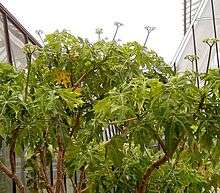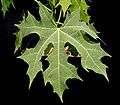Cnidoscolus aconitifolius
| Cnidoscolus aconitifolius | |
|---|---|
 | |
| Scientific classification | |
| Kingdom: | Plantae |
| (unranked): | Angiosperms |
| (unranked): | Eudicots |
| (unranked): | Rosids |
| Order: | Malpighiales |
| Family: | Euphorbiaceae |
| Genus: | Cnidoscolus |
| Species: | C. aconitifolius |
| Binomial name | |
| Cnidoscolus aconitifolius (Mill.) I.M.Johnst. | |
| Subspecies | |
|
C. aconitifolius subsp. aconitifolius[1][2] | |
| Synonyms | |
|
Cnidoscolus chayamansa McVaugh[3] | |
Cnidoscolus aconitifolius, commonly known as chaya or tree spinach, is a large, fast-growing leafy perennial shrub that is believed to have originated in the Yucatán Peninsula of Mexico.[3] The specific epithet, aconitifolius, means "Aconitum-like leaves". It has succulent stems which exude a milky sap when cut. It can grow to be 6 meters tall, but is usually pruned to about 2 m for easier leaf harvest. It is a popular leaf vegetable in Mexican and Central American cuisines, similar to spinach. The leaves should be cooked before being eaten, as the raw leaves contain a high content of toxic hydrocyanic acid. Up to 5 raw leaves can be eaten a day. To be safely eaten, the required cooking time is 5-15 minutes.[5][6]
Taxonomy
Cnidoscolus aconitifolius subsp. aconitifolius is found from northern Mexico to Guatemala and cultivated as far south as Peru, while Cnidoscolus aconitifolius subsp. polyanthus (Pax and K.Hoffm.) Breckon is restricted a small area in western Mexico.
Plants in the Chayamansa Group (syn. Cnidoscolus chayamansa) are the most widely cultivated, because they lack stinging hairs on the leaves. It is divided into four cultivars based on leaf morphology: 'Chayamansa' (most common), 'Estrella', 'Picuda', and 'Redonda'.[3]
Cultivation
Chaya is easy to grow, a tender perennial in the US, and suffers little insect damage. It is tolerant of heavy rain and has some drought tolerance. Propagation is normally by woody stem cuttings about 6-12 inches long, as seeds are produced only rarely. Early growth is slow as roots are slow to develop on the cuttings, so leaves are not harvested until the second year. Chaya leaves can be harvested continuously as long as no more than 50% of the leaves are removed from the plant, which guarantees healthy new plant growth.
A USDA study in Puerto Rico reported that higher yields of greens could be obtained with chaya than any other vegetable they had studied. In another study chaya leaves were found to contain substantially greater amounts of nutrients than spinach leaves.[7]
Consumption
Some varieties have stinging hairs and require gloves for harvesting. Cooking destroys the stinging hairs. Chaya is one of the most productive green vegetables.[8][9]
Chaya is a good source of protein, vitamins, calcium, and iron; and is also a rich source of antioxidants.[10] However, raw chaya leaves are toxic as they contain a glucoside that can release toxic cyanide. Cooking is essential prior to consumption to inactivate the toxic components; in this chaya is similar to cassava, which also contains toxic hydrocyanic glycosides and must be cooked before being eaten.[11]

Young chaya leaves and the thick, tender stem tips are cut and boiled as a spinach. It is a tasty vegetable, and is exceptionally high in protein, calcium, iron, and vitamin A.[9] In fact, levels of chaya leaf nutrients are two- to threefold greater than any other land-based leafy green vegetable.[12][13] Chaya leaves have a possible antidiabetic effect.[12]
Traditionally leaves are immersed and simmered for 20 minutes and then served with oil or butter. Cooking for 20 minutes or more will render the leaves safe to eat. The stock or liquid the leaves are cooked in can also safely be consumed as the cyanide is volatilized as hydrogen cyanide (HCN) during cooking. Cooking in aluminum cookware can result in a toxic broth, causing diarrhea.[13]
References
- 1 2 "EOL Search: Cnidoscolus aconitifolius". Encyclopedia of Life. 4 June 2010. Retrieved 28 June 2010.
- 1 2 "Search Results for: Cnidoscolus aconitifolius". Global Biodiversity Information Facility. Retrieved 28 June 2010.
- 1 2 3 G.J.H. Grubben, O.A. Denton, eds. (2004). Plant Resources of Tropical Africa. 2: Vegetables. PROTA Foundation. pp. 200–201. ISBN 978-90-5782-147-9.
- ↑ "Taxon: Cnidoscolus aconitifolius (Mill.) I. M. Johnst.". Germplasm Resources Information Network. United States Department of Agriculture. 1997-05-22. Retrieved 2011-05-31.
- ↑ https://books.google.com/books?id=6jrlyOPfr24C&lpg=PA200&vq=chaya&pg=PA200#v=snippet&q=chaya&f=false
- ↑ http://people.umass.edu/psoil370/Syllabus-files/Chaya.pdf
- ↑ http://people.umass.edu/psoil370/Syllabus-files/Chaya.pdf
- ↑ http://www.echotech.org/technical/az/aztext/azch2veg.htm#Chay
- 1 2 "The nutritive value of chaya, one of the most productive green vegetables". Ideas for growing food under difficult conditions - From Amaranth to Zai Holes - ECHO / ECHO development notes.
- ↑ Kuti, J. O.; Konuru, H. B. (2004). "Antioxidant Capacity and Phenolic Content in Leaf Extracts of Tree Spinach (Cnidoscolus spp.)". Journal of Agricultural and Food Chemistry. 52 (1): 117–21. doi:10.1021/jf030246y. PMID 14709023.
- ↑ James M Stephens. "Chaya — Cnidoscolus chayamansa McVaugh". University of Florida IFAS Extension.
- 1 2 Kuti, Joseph O.; Torres, Eliseo S. (1996). J. Janick, ed. "Potential nutritional and health benefits of tree spinach". Progress in New Crops: 516–520.
- 1 2 "Chaya, the Maya miracle plant". Mexconnect. October 2009. Retrieved 2011-05-31.
- Ross-Ibarra, J. and A. Molina-Cruz (2002). "The Ethnobotany of Chaya (Cnidoscolus Aconitifolius ssp. Aconitifolius Breckon): A Nutritious Maya Vegetable". Economic Botany. 56 (4): 350–365. doi:10.1663/0013-0001(2002)056[0350:TEOCCA]2.0.CO;2. Retrieved 2007-09-19. (subscription required (help)).